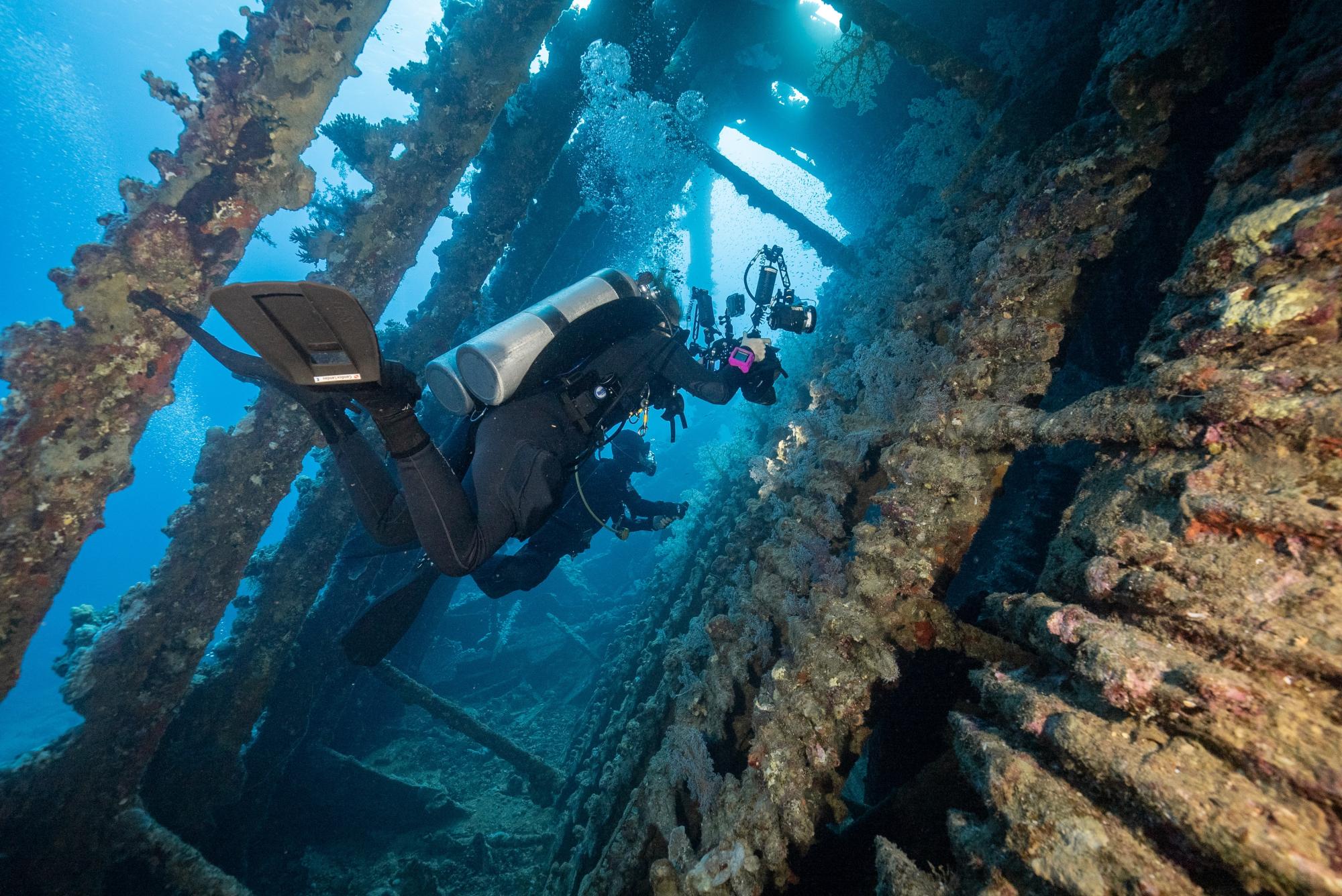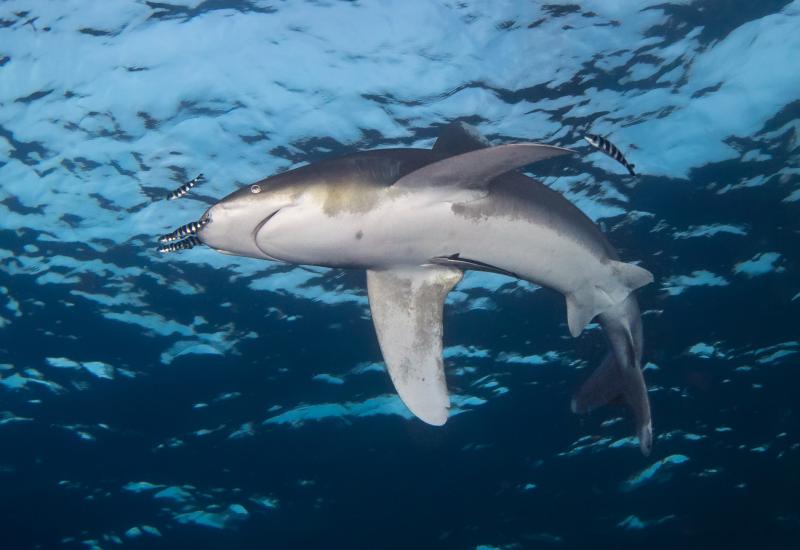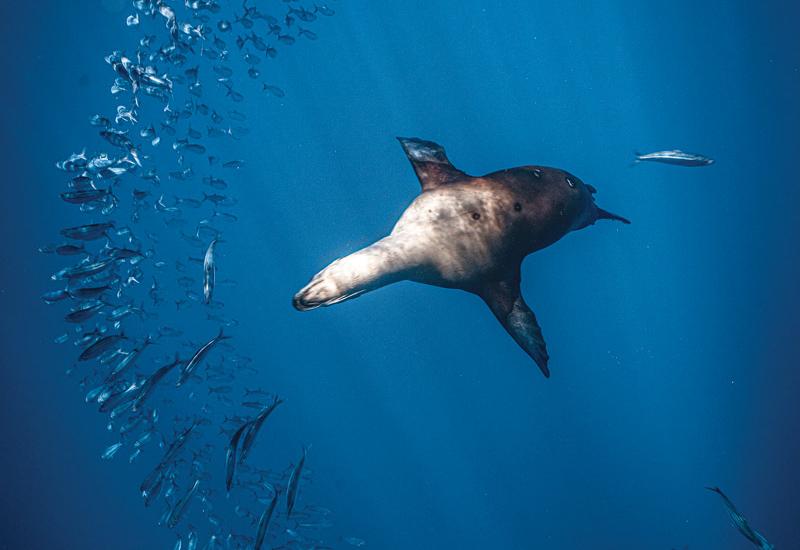Delve Into Tec Diving on a Red Sea Vacation
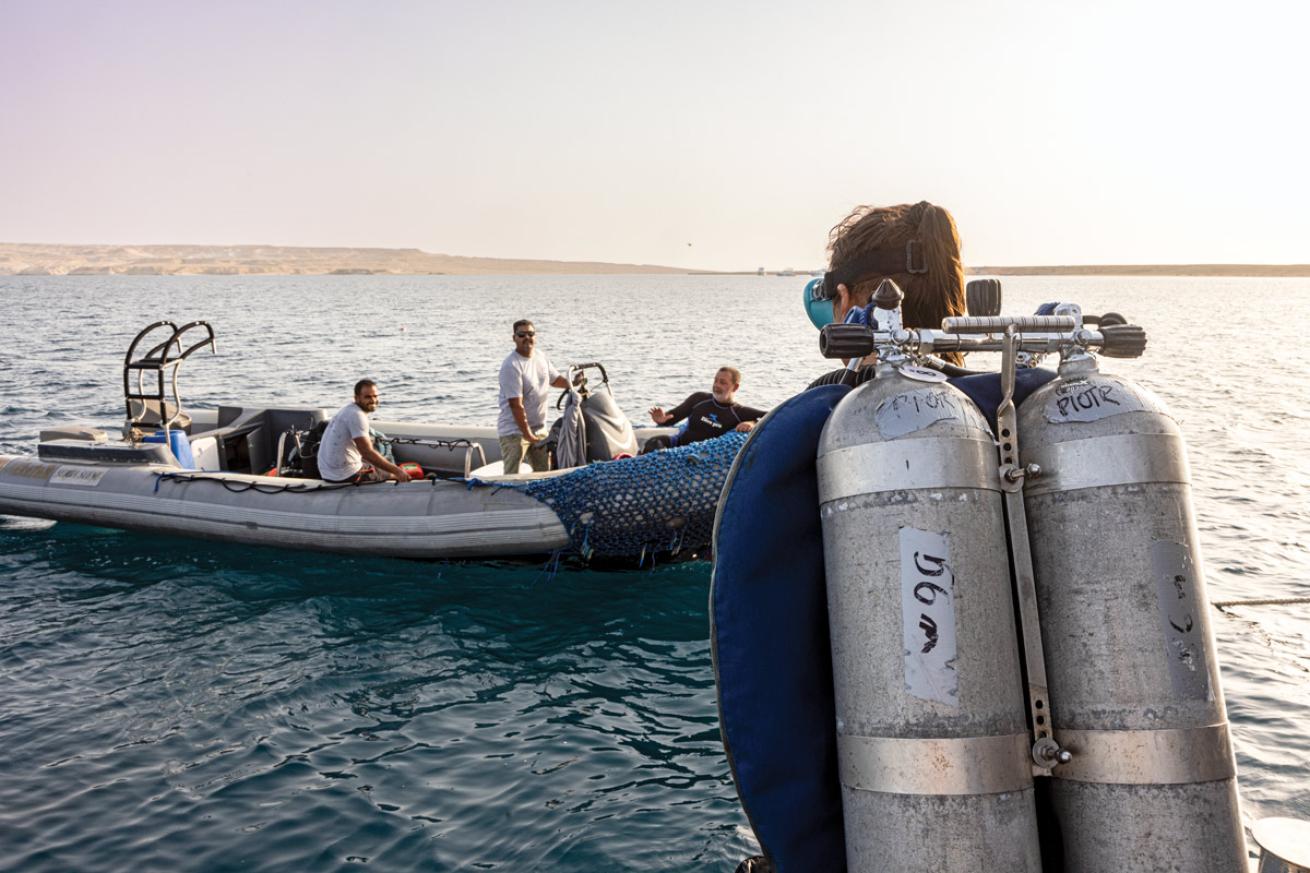
Candice LandauKristin waits to board a Zodiac headed to the next dive site.
The wreck we’re descending on is not like the formidable cargo ships I dived in Chuuk Lagoon a few months ago. Giannis D appears suddenly, torn in two, the glittering blue of the Red Sea’s clear, calm waters refracting light over the immense funnel, the crane, the bridge and some of the largest corals I’ve ever seen, flat and textured like lacy toffee wafers.
This trip is supposed to be where my buddy and Scuba Diving magazine colleague Kristin Paterakis and I experience what it’s like to tec dive from a liveaboard while on vacation. Though I have a few dozen dives on backmount doubles, I have very little experience with decompression diving. This assignment will be as much about capturing what it’s like to dive the wrecks of the Red Sea as it will be about getting comfortable in tec gear and the skills associated with it.
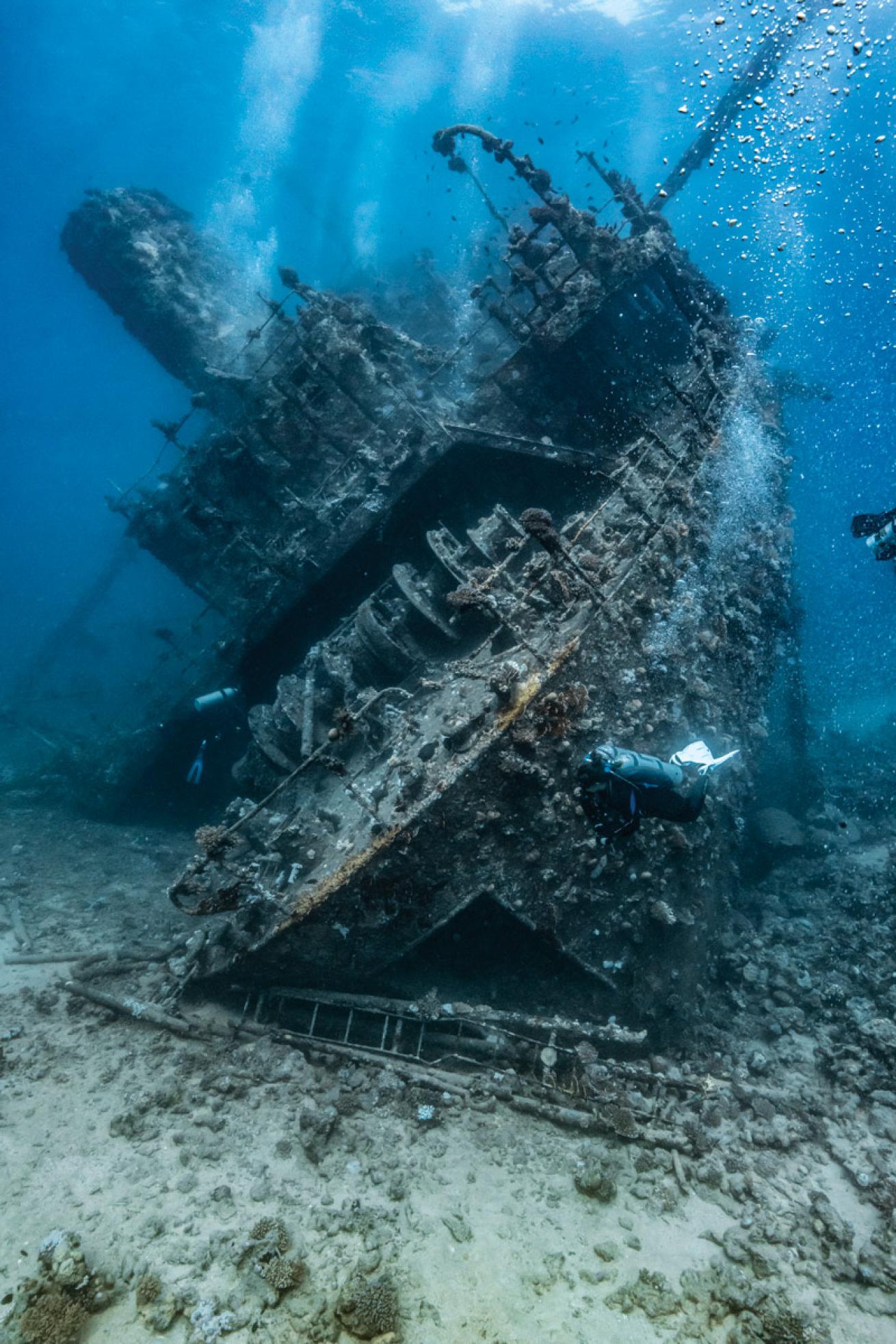
Candice LandauKristin explores the stern of the Giannis D wreck
Our guide for the dive is Ahmed Fadel, an experienced tec instructor and the host of this week’s Wrecks of the North itinerary with All Star Liveaboards. Ahmed has kindly offered to guide me and Kristin on a tour through the stern.I suspect he may also want to get a sense of how we dive before he agrees to tackle the bigger, deeper wrecks with us. We won’t be getting into deco on this dive.
While wreck diving is arguably my favorite type of diving, penetrating wrecks still makes my stomach coil with nerves. Following someone into a wreck is an exercise in trust, attention and good communication.
The Giannis D lies at 88 feet of depth. Outside of the largely intact stern section, it is a gutted mess of wood and indecipherable, coral-encrusted debris. Above it all, the Sha’ab Abu Nuhas Reef rises, an ominous reminder of how this cargo ship sank in 1983.
As we frog-kick slowly through the interior, I am pleasantly surprised to find there are many openings. Sun streams through, lighting the carpet of silt in a golden glow. It’s a somewhat disconcerting penetration as the stern is listing. Distinguishing roof from wall from floor isn’t as intuitive as it might seem from outside.
I close my eyes momentarily to stop the dizziness it’s causing. Surprisingly, diving doubles instead of a single tank doesn’t feel encumbering. I can still easily fit through small spaces, and I am more relaxed knowing I have additional air on my back.
Related Reading: The Best Destinations for Wreck Diving
Following someone into a wreck is an exercise in trust, attention, and good communication.
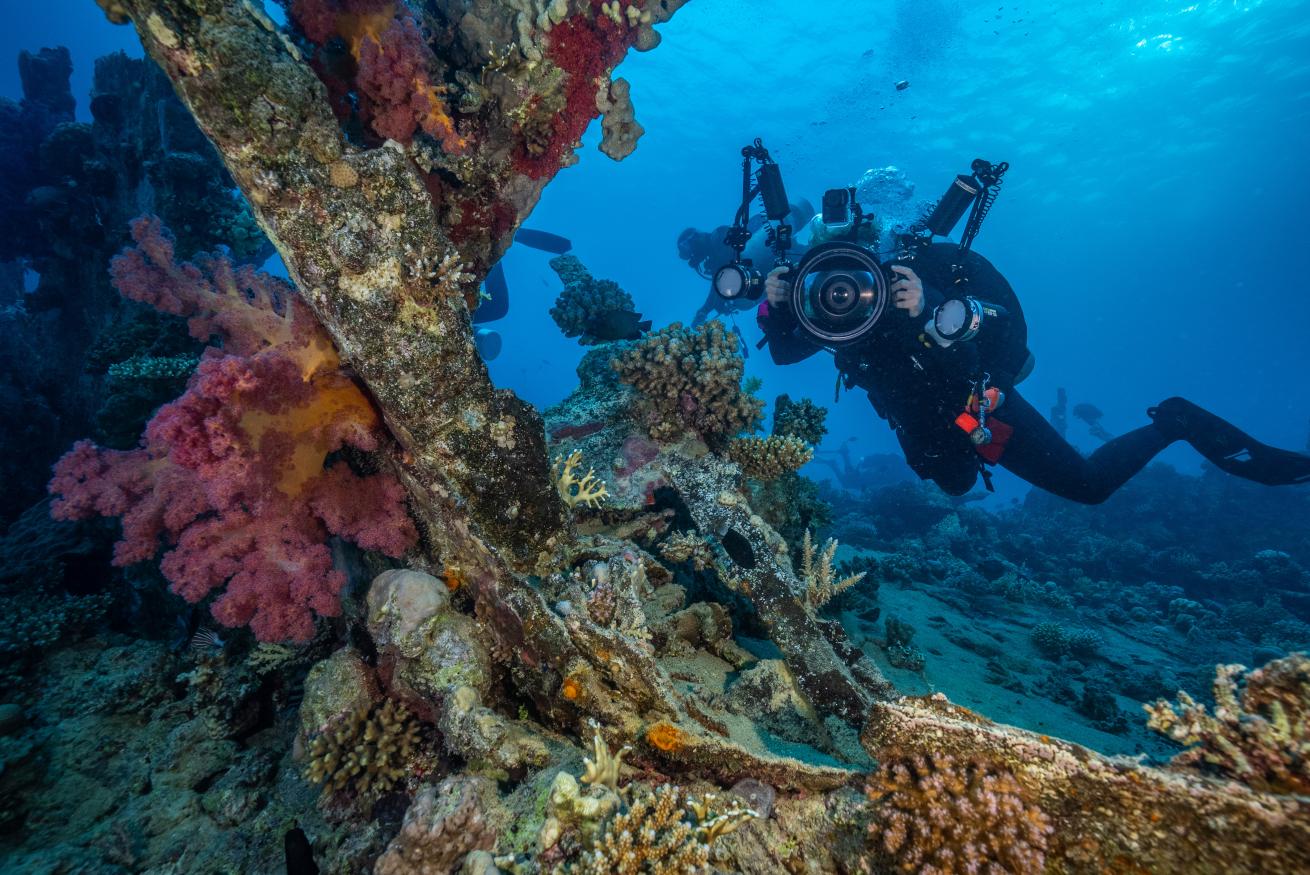
Kristin PaterakisCandice quickly learning how to use her new underwater camera in the shallow and vibrant Red Sea waters.
Once outside the wreck again, Kristin and I are in our element, at ease without an overhead environment or fear of stirring up silt. We begin experimenting with my underwater camera rig—she poses while I shoot. It’s not an easy exercise. I realize I don’t have the hand signals to tell her to smile with her eyes or a spare hair band to capture the ponytail that streams across her face.
When we surface, the guides on the Zodiac hold the manifold on my doubles. I undo my harness, slip it through the crotch strap and then wiggle out. Prior to this trip I’d never dived doubles off a Zodiac, but two dives in, I’m already feeling comfortable.
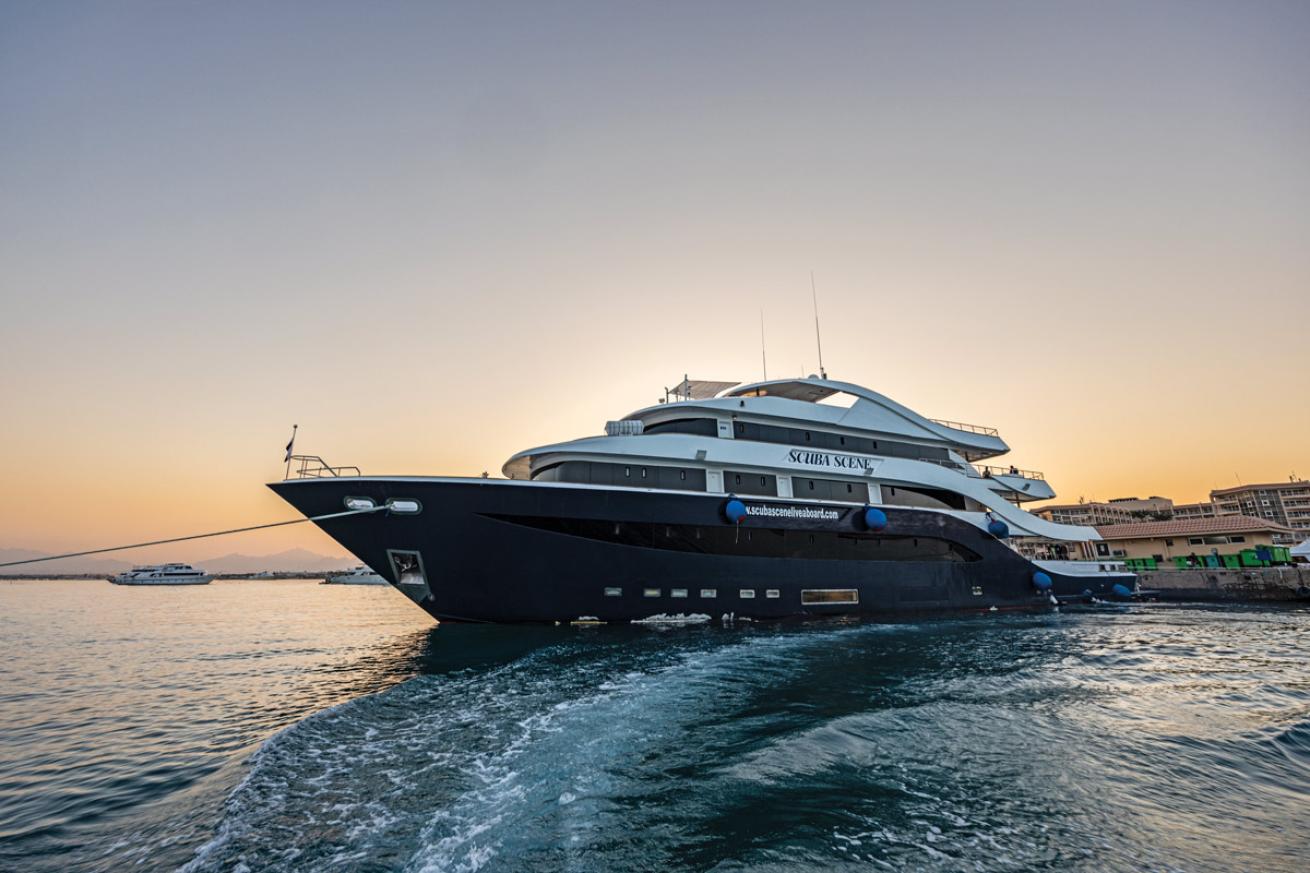
Candice LandauAll Star's newest liveaboard Scuba Scene docked in Hurghada, Egypt
You'll Want For Nothing
The day before we dive Giannis D, Kristin and I arrive at the dock in Hurghada, Egypt. Five decks high, All Star’s newest liveaboard, Scuba Scene, towers over the nearby boats, a steel-hulled behemoth with wooden decks, silver railings and a gleaming white body.
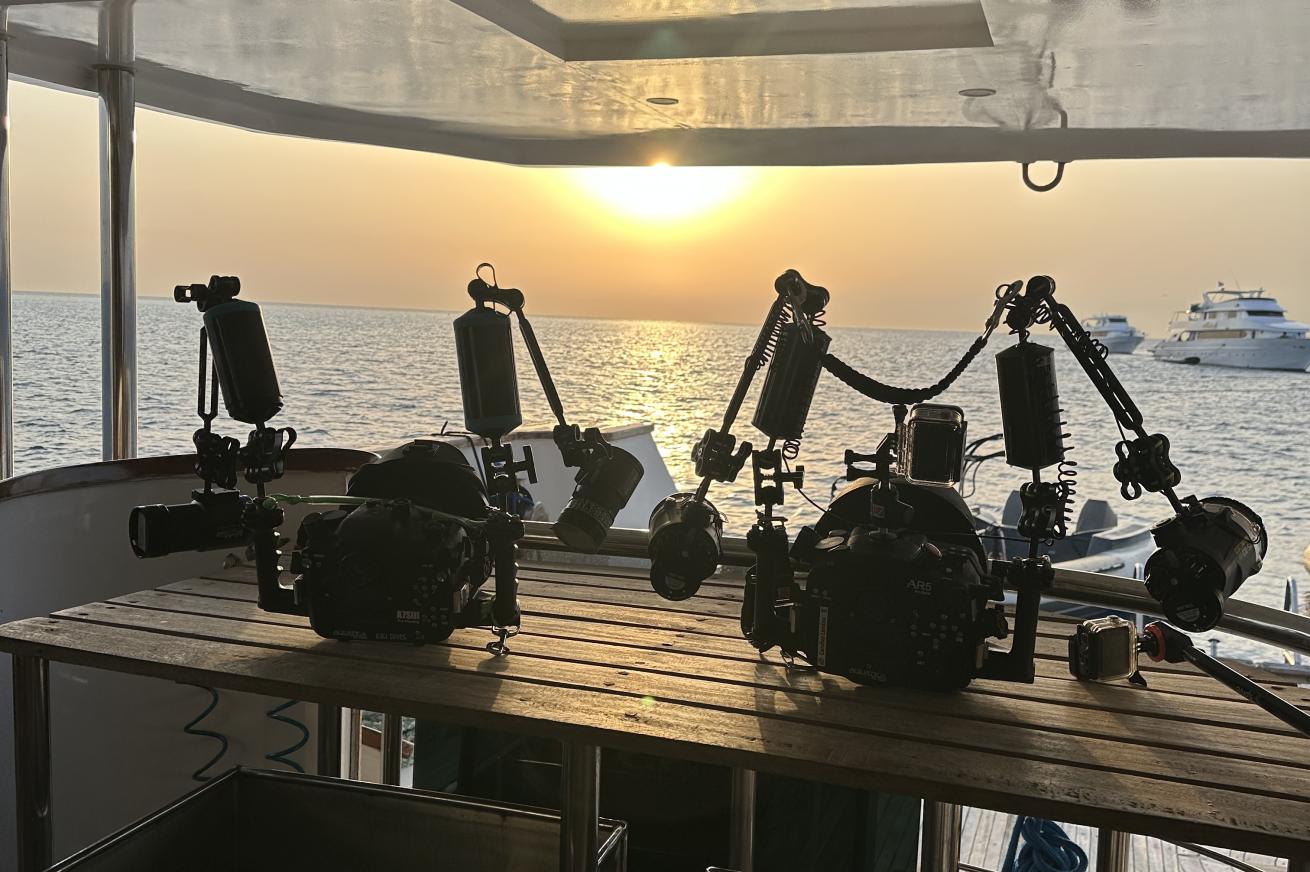
Kristin PaterakisThe luxury liveaboard comes with a wet and dry rack for our cameras.
In the distance, faintly visible through the afternoon haze, arid mountains skim the city skyline; palm trees, hotels and abandoned buildings only discernible in silhouette. This is where we first meet Ahmed, who gives us a tour of the yacht before the other guests arrive.
It’s the most luxurious liveaboard I’ve been on. There’s both a wet and dry camera table, multiple rinse buckets and stations, an actual swimming pool, a jacuzzi, a bar, a couple of open-air lounges, a TV room, large private bathrooms in every cabin, a salon and extremely well-thought-out safety features. We poke our heads into the dive-themed cabins—wrecks, lionfish, turtles—and admire the tinted windows that span the full width of every room.
The dive deck is my favorite space of all. It’s the beating heart of the ship, pulsing with activity as the crew wraps lines in place, screws whips to tanks, and prepares rental gear for those who’ve requested it. The mix of single and double tanks is also oddly exciting, and Ahmed tells us we’re waiting on a group of regulars from Northern England and Scotland.
| TEC: A Gateway To Adventure PADI’s Tec 40 course is the ideal starting point for divers venturing into technical diving, offering foundational skills and principles for dives up to 130 feet, or 40 meters. The Sidemount Diver course complements this by teaching divers to manage single cylinder tanks on either side of the body, especially useful where twin setups are unavailable. Learn More |
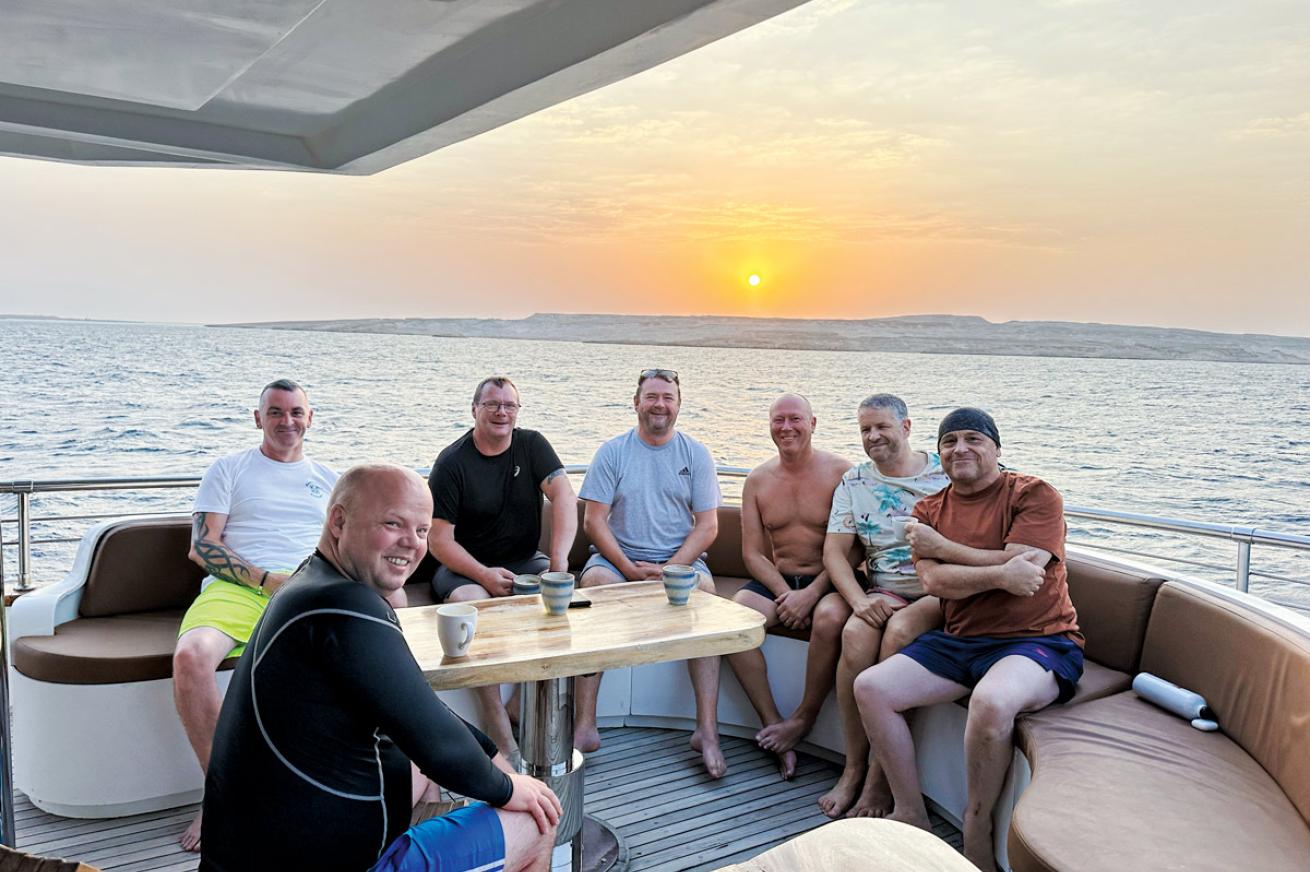
Kristin PaterakisOur new British friends enjoying coffee at sunrise.
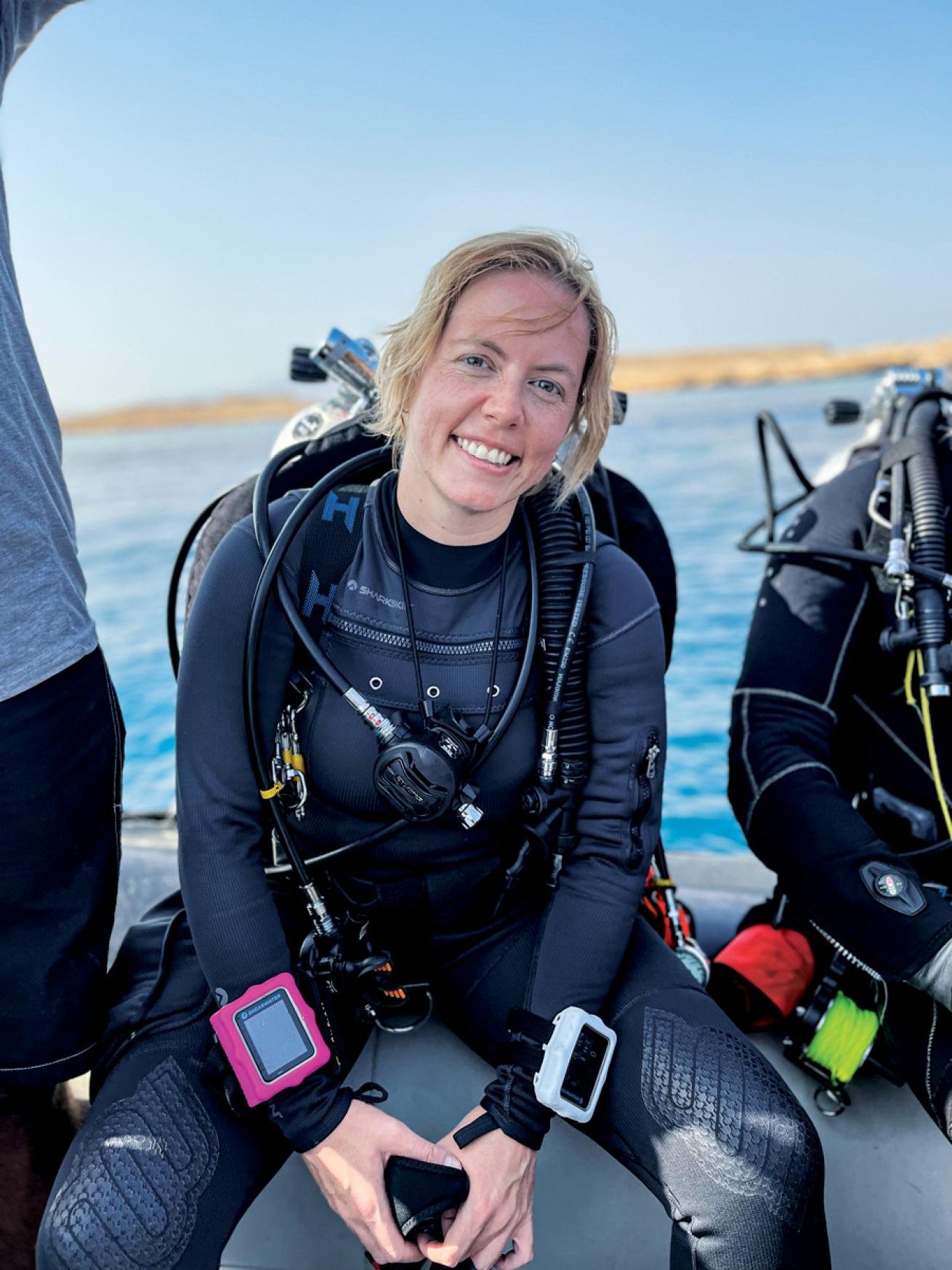
Kristin PaterakisCandice waits to back-roll after a bit of friendly banter.
When Kristin and I meet the other passengers, we’re struck first by their lilting accents and their diction—“whey eye man” in place of “OK”—and then by the many different configurations they’re diving. Some are in backmount doubles like us, others in single tanks, and one or two have a single tank and a deco bottle, or are in the sidemount setup
Where Kristin and I both dive a Halcyon backplate, wing and harness with a backup regulator on a necklace and an extra-long hose for potential out-of-air situations, others have configurations we’ve never seen before. Kristin politely points out to one fellow that his regulator is on the wrong side of his wing. He looks momentarily confused and then explains that it’s intentional: Many British Sub-Aqua Club divers adopt this setup. Clearly, we have a thing or two to learn.
Later, Kevin Brookes, one of the divers from Newcastle upon Tyne, tells me that if we ask for doubles rather than a “twinset” in the U.K., we’ll get something quite different—I suspect an alcoholic beverage.
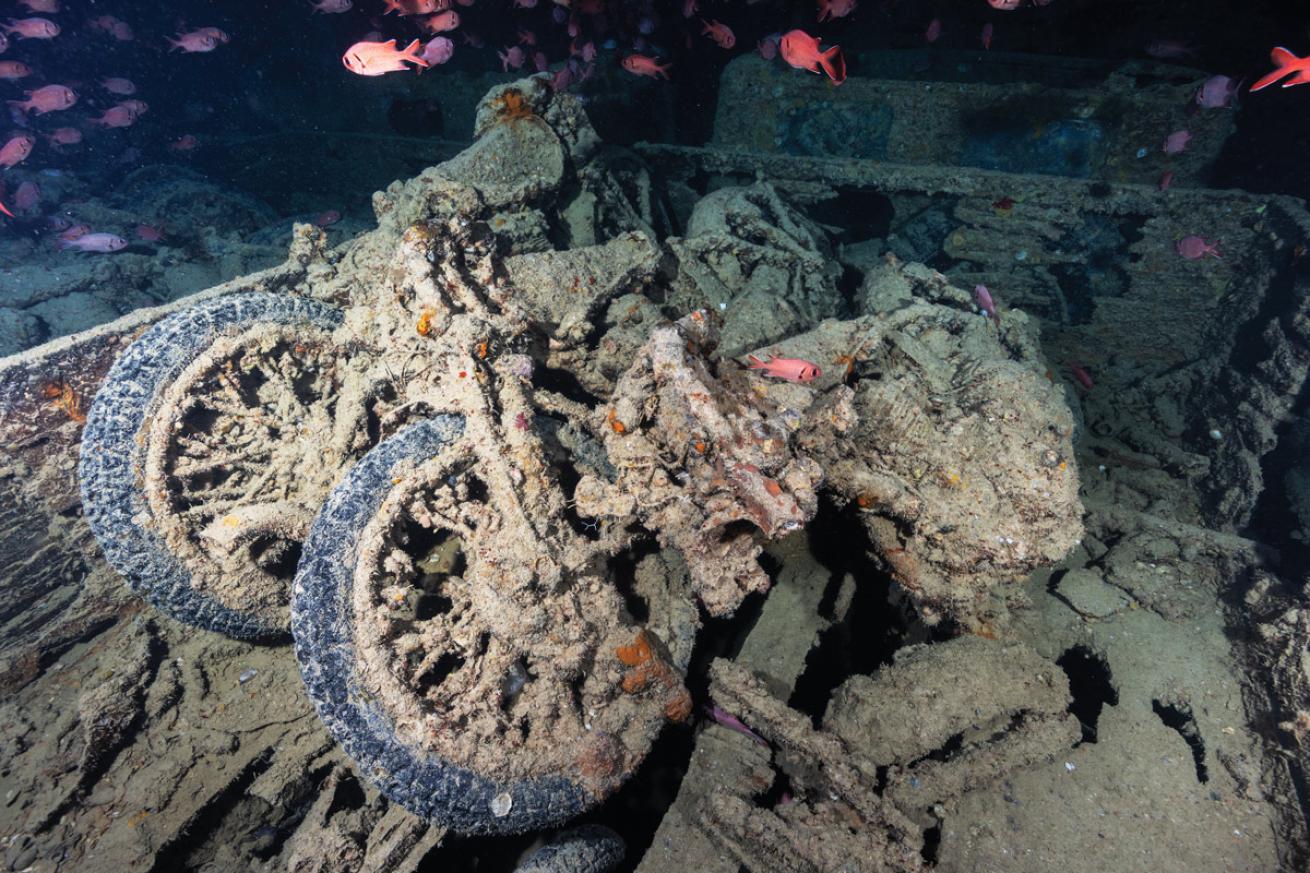
Candice LandauDiving the SS Thistlegorm multiple times is recommended so divers can see the various levels of the vessel filled with trucks, motorcycles, rifles, aircraft parts, ammunition and rubber boots.
Relics of Wartime History
On Day Three, When It Comes Time to Dive the SS Thistlegorm, I try to keep my expectations in check. Though visibility on the first dive isn’t great, but like everybody else, I am enthralled. The wreck is so large—415 feet in length—that discovery is a slow process. It's also packed with interesting paraphernalia. I’m grateful we’re diving it more than once.
Kristin and I want deco practice, so we spend time in the sand at 100 feet, puttering around the port-side locomotive, investigating projectiles and military tanks that lie in the crushed remains of hold four, still identifiable beneath layers of silt, rust, and algae.
Sunk during World War II by German bombers, the Thistlegorm is a portal to the past. Inside its open holds, we see Ford and Bedford trucks, jeeps, motorcycles, rifles, aircraft parts, ammunition and rubber boots. No inch of metal has been spared the passage of time or the corrosive effect of saltwater. Only the rubber tires on the vehicles look as though a quick scrub will have them ready to use. Curious amber squirrelfish give me the side-eye as I absorb the recent past.
The scale of what we can explore means we use up every second of allowed dive time. Both Ata and Bara’a, our dive guides, have to leave early on account of diving single cylinders, but not before they show us what to take pictures of.
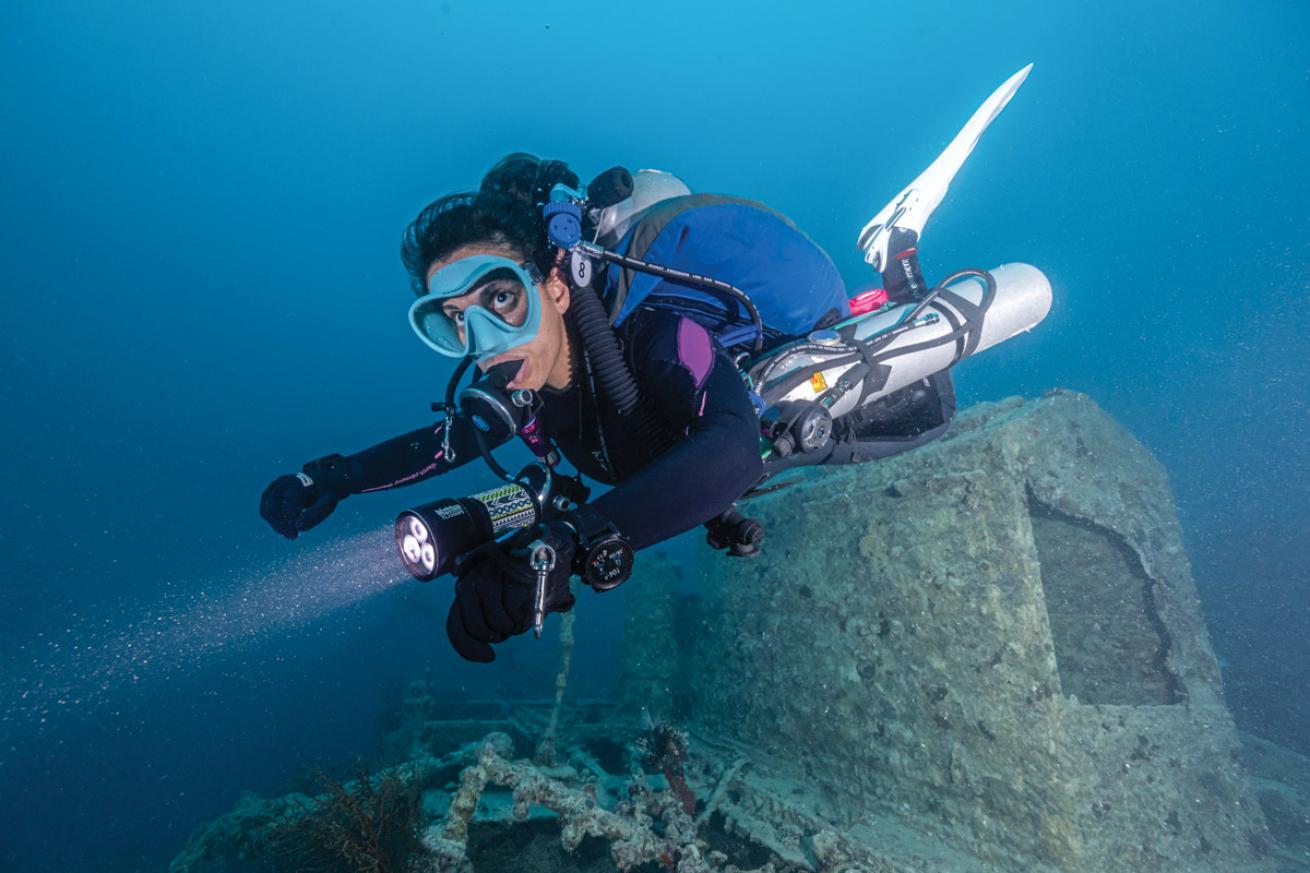
While the Thistlegorm is “the wreck” to dive for many, the Rosalie Moller, sunk just two days after it in October 1941, has an unfortunate backstory. So powerful was the explosion from the Thistlegorm’s bombing that for a brief moment, the night sky was lit up, exposing Rosalie Moller’s location in a supposed safe harbor. It’s also a favorite site for fellow passenger Tony Freeman, who admits the most memorable part of his dives is “watching the wreck appear when arriving.”
Related Reading: World's Best Destinations for Underwater Photography
An Oasis Alongside A Desert
Unlike many of the wrecks that have been broken up by war, the elements, or salvagers, Rosalie Moller remains largely intact, sitting upright on the seabed. The depth, between 100 and 150 feet, adds challenge, and the visibility, a little grittier today, adds an element of foreboding that can make wreck diving feel all the more mysterious and enticing.
A den of lionfish has made its home here, as have a few anemonefish that stare Kristin down while I take a photo. Though neither of us drops much deeper than 140 feet, we both accrue deco.
On our deco stop, Ata makes bubble rings using air from his regulator’s exhaust. No matter how hard I try, pulling my exhaled air down in front of me and then quickly pushing it away with my fists, it’s a skill I cannot replicate.
No inch of metal has been spared the passage of time or the corrosive effect of saltwater. Only the rubber tires on the vehicles look as though a quick scrub will have them ready to use.
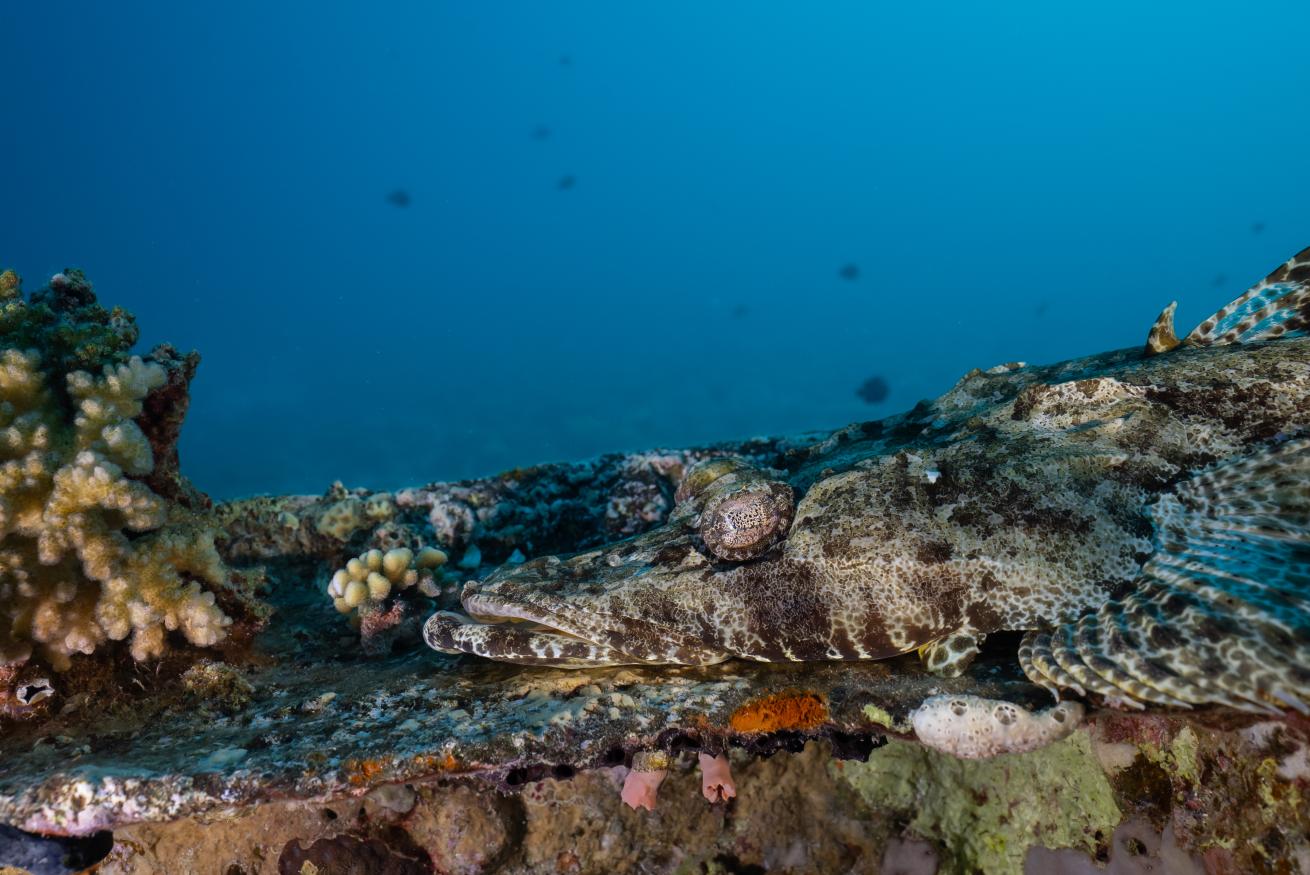
Kristin PaterakisCrocodile fish, with a stunning camoflauge eye that changes it's leafy-like design.
The Barge is where I have a charming interaction with an orange-lined triggerfish that can’t stop investigating its own reflection in my camera’s dome port. It’s also where I see my first crocodilefish buried in the sand and a white snowflake moray eel right alongside a giant moray that needs to lose a few pounds to fit inside its den.
Kristin and I are the last to surface, using up every moment of our allotted hour, ever grateful for the true value of a set of doubles—more bottom time and emergency gas if necessary.
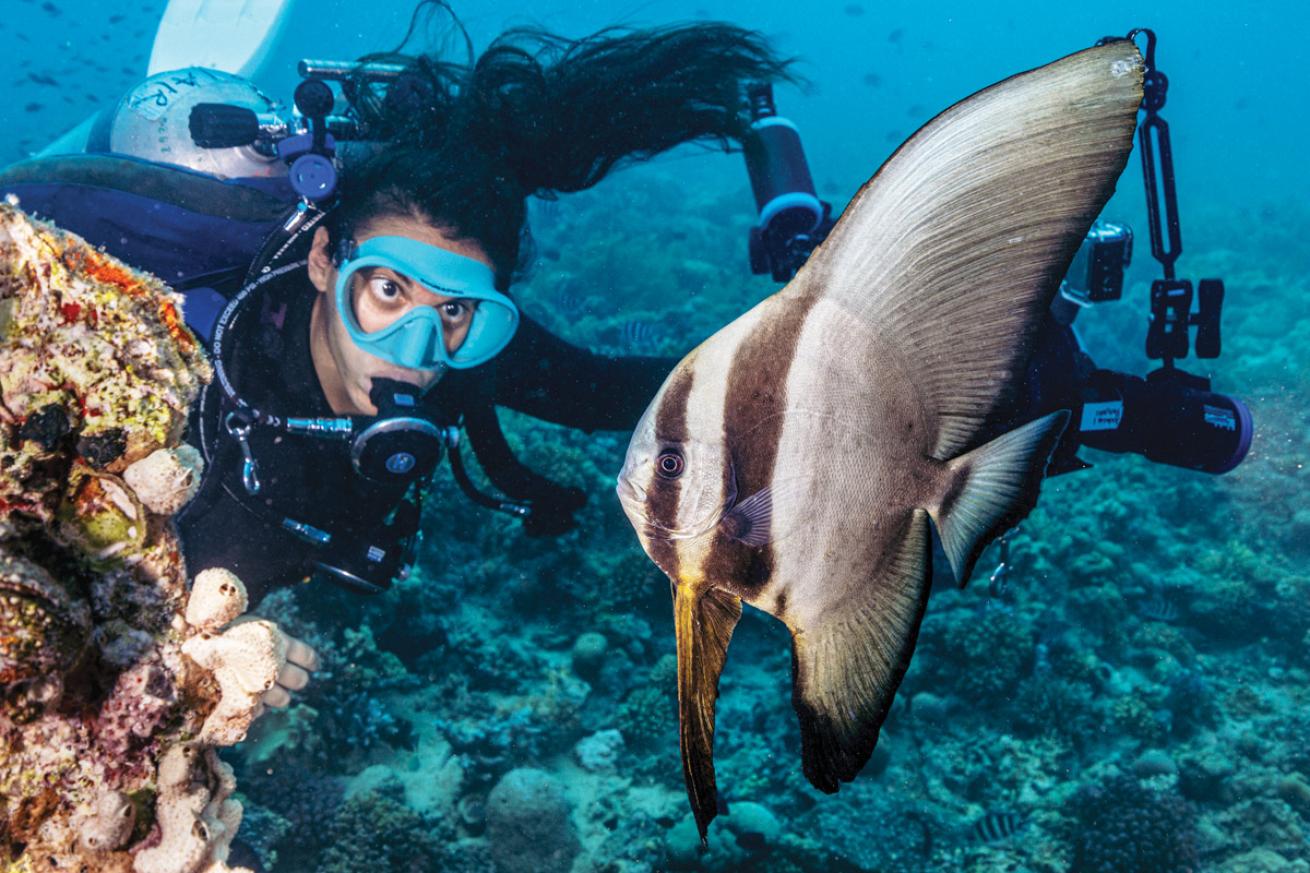
Candice LandauKristin has a moment with a curious batfish on the Barge, a wreck all photographers adore.
Multiple Motivations
Though we’re not on one of All Star’s tec week itineraries, I think the Wrecks of the North itinerary is a good way to experience what the Red Sea has to offer and a good place to get comfortable with tec diving equipment.
While tec diving may seem a singular pursuit—stay down longer, dive deeper—the motivations drawing individuals to it are as varied as the divers themselves.
I took my first tec course in Washington State in 2018 because I love learning. It was only later that I truly recognized the value of being able to stay down longer in order to see and explore more.
For Scotland-based Sam Mitchell, the youngest of the passengers on our boat, it’s all about getting the most out of a dive. “On a trip to Scapa Flow in Orkney, I noticed I was coming to the surface 30 minutes earlier than the other divers on twinsets, and that was with using nitrox!”
I often draw parallels between a Nitrox certification and a Tec certification as both allow for extended dive times in their own way.
Where Sam needed extra breathing gas to buy himself more bottom time, first-time Red Sea diver Marc took the tec route to get to deeper wrecks. “I decided to get into tec diving as many of the shallower inshore wrecks along our coastline have deteriorated and collapsed over the years. I was drawn to the more intact wrecks which lie in deeper water, making tec certification a necessity.”
Related Reading: Stunning Summer Scuba Vacations
Many divers are surprised to learn that those of us with tec training get the training and don the equipment to have more time at even recreational depths. Put me in a set of doubles, and I’ll spend two hours on a warm, shallow reef—no deco required.
To explain the benefit of tec diving to friends, I often draw parallels between a nitrox certification and a tec certification as both allow for extended dive times in their own way. Though we’re all explorers at heart, our motivations for getting into tec are many and varied.
The Wrecks of the North itinerary is more than a wreck-hop. It’s space and time to immerse myself in the comforting sensation of water pressure, to reflect on stories from the past, and then to explore how nature and the passage of time have interacted with these stories, turning them into living reefs and meditative experiences. Sign me up for next year!
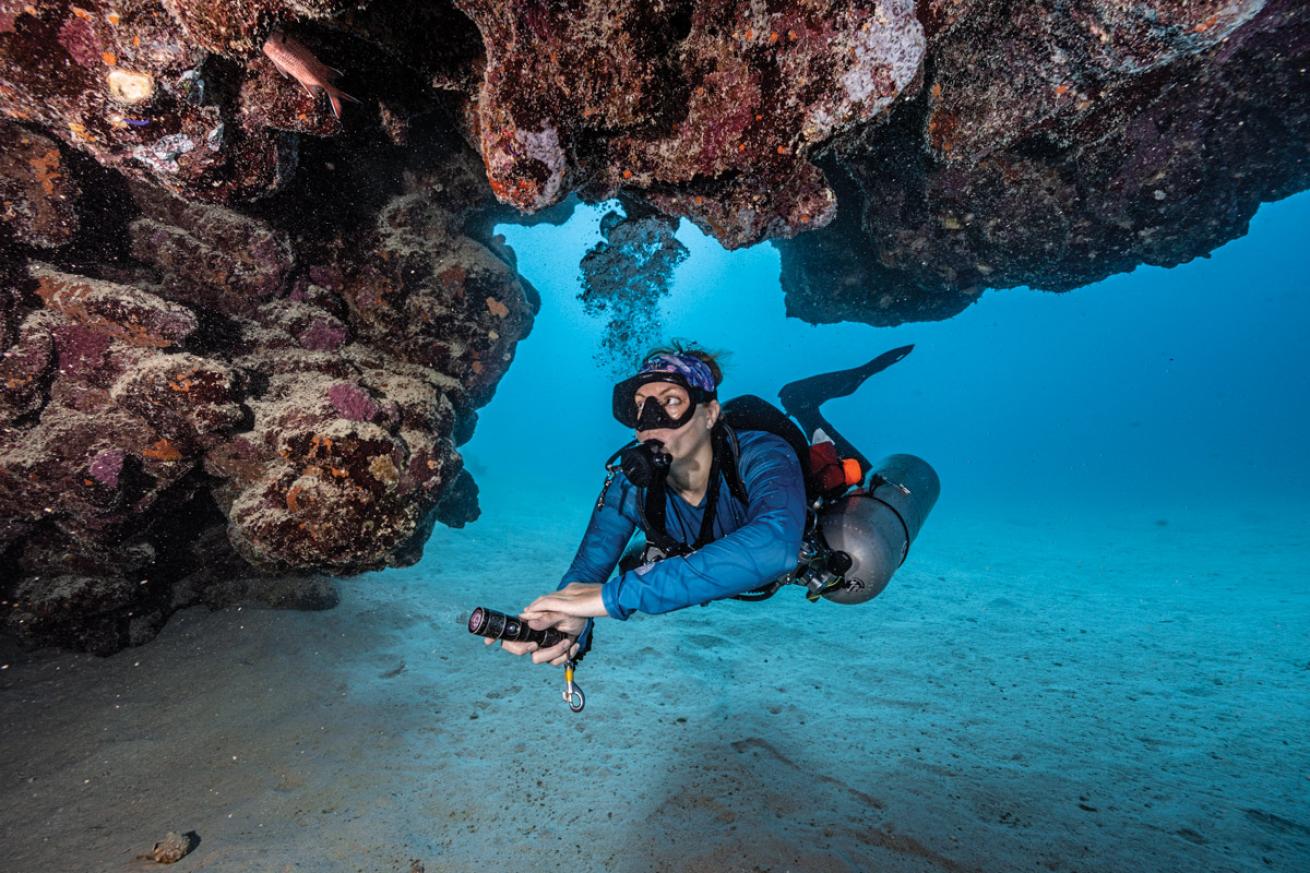
Kristin PaterakisCandice dives sidemount at Marsa Nakari
Discovering Sidemount
After a week of liveaboard diving, we head south to renowned eco-resort Red Sea Diving Safaris. Our goal: to dive the iconic Elphinstone Reef. The on-site course director, Hossam Abdelaziz, challenges me to swap my doubles for a sidemount setup, his preferred configuration for ease and streamlining.
Hossam’s training quickly reshapes my underwater experience. It’s remarkably pleasant to not have anything on my back. Rather, I have an aluminum 80 bungeed and clipped to each side of a triangular wing. My balance and trim in the water are immediately better, and I love practicing removing a tank and swimming with it in front of me as though it’s a scooter.
With warm, clear water and easy access to both shore and boat diving, I can’t imagine a better place to take a diving course. Though I stick to backmount doubles for Elphinstone—there’s safety in familiarity—I do complete a couple of deco dives on sidemount.
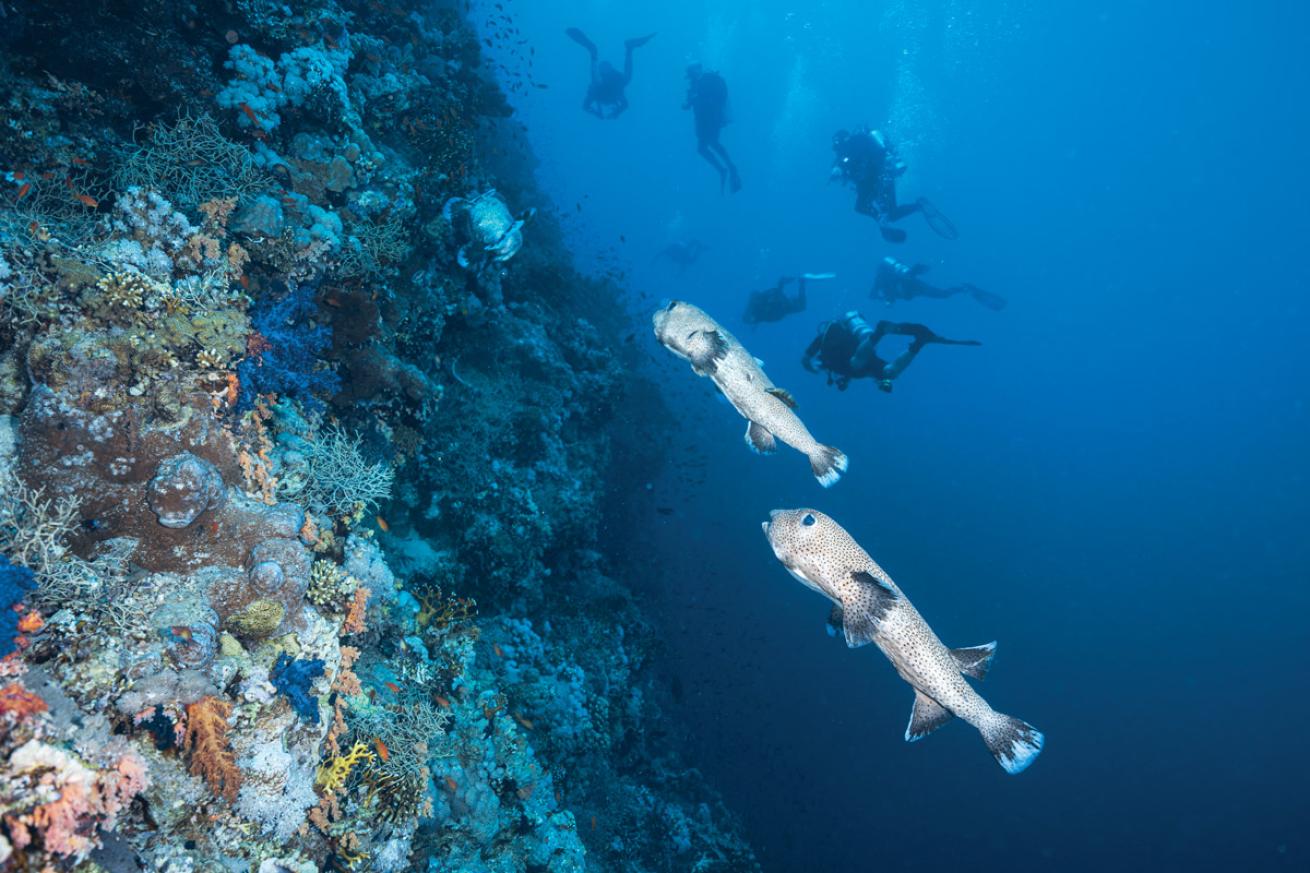
Candice LandauA trio of porcupinefish plays at Shark and Yolanda reefs.
Need To Know
Conditions Water temps 72–82°F; air temps 70–93°F. Consistently excellent visibility.
Best Times to Go
Dec–April North, Tiran, Ras Mohammed.
May–July Southern Egypt (Daedalus, St. John’s, Rocky Island, Zabargad).
July–Sept Mixed itineraries; ideal for tec courses due to warm waters.
Sept–Nov Peak shark season at Brothers, Daedalus, Elphinstone.
Tec Diving Best on northern itineraries; select others possible.
Getting There Primarily from Hurghada; Port Ghalib for May–July. Transfers from Hurghada to Port Ghalib are available.
Stay Hurghada Marriott Beach Resort.
Operator All Star Liveaboards (allstarliveaboards.com)
Fees Prices start at $1,730; 10% VAT; $100/week nitrox. Other charges may apply.

